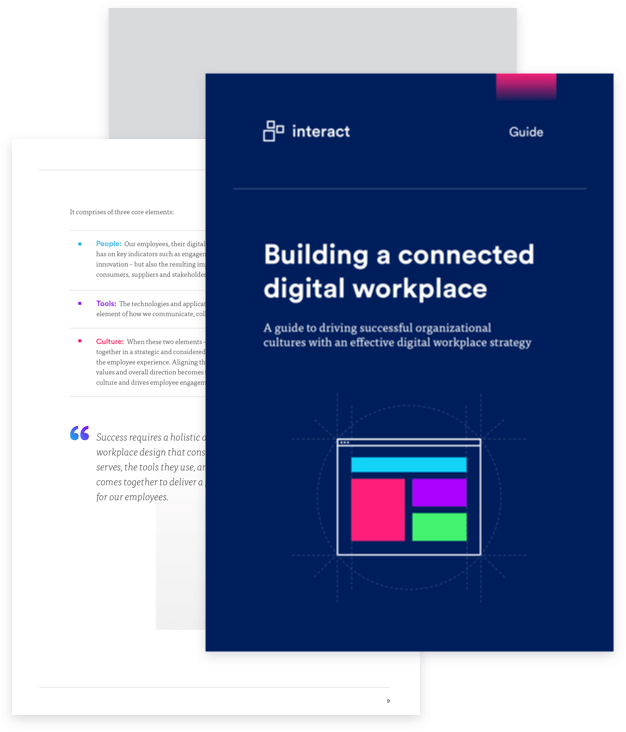The power and potential of People Analytics

Why IC has a critical role to play in transforming the future of our data-driven workplaces
As data within our organizations continues to explode, it’s the relationship between IC, HR and our digital workplaces that will transform the future of work through applied people intelligence: if we start listening.
Data is the topic of the century. How do we collect it, how do we understand it, how do we protect it? What do we do off the back of it?
It’s a focus for good reason. As we increasingly deal in information, data gives us that much-needed edge over competitors when it comes to understanding our consumers or markets, identifying opportunity and risk, or applying data-driven decision-making within our organizations.
Artificial intelligence, algorithms, increasingly minute analysis of our every action are all propelling this data age forward. We’re already experiencing the benefits as consumers: whether that’s in the form of personalized promotions or technological innovations that improve how we work and live.
In true form, the workplace is catching on. People or HR analytics have been a feature in organizations for years, but more recently there’s a shift.
People analytics, also known as HR analytics and workforce analytics, is the use of people data in analytical processes to solve business problems.
CIPD
It’s a responsibility that typically resided with HR and fed upward to management, and it’s had its limitations. We started with demographical data – the basics like age, gender, job title. We could apply a retrospective understanding of a volume of that information to steer future decisions.
Now, we’re entering something far more exciting: more data than ever before, and advanced capabilities for capturing, analyzing, and understanding it.
We can make strategic decisions based on real-time information already residing in our organizations. We can deliver tangible, measurable value at every level, from the individual employee to consumers, the business and its shareholders. People analytics can quite literally transform the future of how we work. If, that is, we actually start listening.
Building a connected digital workplace
What can people analytics and data really impact?
There are a lot of claims about the power and potential of people analytics.
In its Human Capital Trends evaluation in 2017, Deloitte Insights points to the use of data to do everything from help senior leaders understand attrition, hiring metrics, employee cost and employee engagement, through to operational performance information that can help predict patterns of fraud, show trust networks, analyze hourly labor to identify patterns of overtime or payroll leakage, and more.
Use of people data is now about complete workforce management and operation, and how that subsequently translates into business outcomes.
At global tech giant IBM, artificial intelligence has replaced 30 percent of the organization’s HR staff and through the process of machine learning, can predict which employees will leave a job with a staggering 95 percent accuracy, saving them an estimated $300 million in retention costs to date.
Meanwhile Google – always a front leader when it comes to workplace innovation – was described as ‘reinventing HR’ by thought leader Dr John Sullivan in 2013, after the firm deployed a ‘people operations’ function that used data-based decision-making and algorithms to guide its choices.

“Many of Google’s people analytics approaches are so unusual and powerful,” Dr Sullivan writes, “I can only describe them as ‘breathtaking’.”
He points to the tech powerhouses’ ‘PiLab’ subgroup, which conducts applied experiments within Google to determine effective approaches for managing people and maintaining a productive environment. The lab actually improved employee health by reducing the calorie intake of its employees at their eating facilities by relying on scientific data and experiments – simply by reducing the size of the plates.
Unlike people analytics of old, these are metrics and solutions that are business-driven, rather than purely HR focused. Use of people data is now about complete workforce management and operation, and how that subsequently translates into business outcomes.
We don’t work in the industrial era any longer; people are our power. Managing them effectively is necessary for innovation and organizational longevity.
Building a connected digital workplace
Where does Internal Communications come into it?
If people data – by the very name – is HR’s domain, why should Internal Comms be stepping up to the people analytics challenge?
The Internal Communications function is now established and gaining gravitas at the C-suite level; becoming more strategic and aligning with long-term business objectives.
As part of that process, we’re using a plethora of different digital tools to execute IC and recognizing the importance of measuring outcomes and success. In short, we’re already gathering valuable data.

The focus on delivering greater employee experiences and driving employee engagement is also seeing stronger partnerships between HR and IC. We understand our staff are our USP, our greatest asset. People costs often approach 60 percent of corporate variable costs and have a direct impact on delivery of customer experience, productivity or output, and financial success. If it’s not obvious already, staff = extremely important.
Our people are already talking to internal comms, and it’s all data HR – and our organizations as a whole – can learn from. Why wouldn’t we be listening?
With that understanding, internal communication is now decidedly two-way. We’re not just pushing corporate memos down from head office. We’re proactively tapping into employee sentiment and having conversations; whether that’s with the annual staff survey, pulse surveys, social tools, focus groups, usage analytics and more. We post a news item, send out a newsletter, put a piece of content on the intranet – and our staff interact and engage. Every action they take, tells us something.
When we put those engagements into the right models and alongside the multiple data inputs from all over our organizations, we build a bigger picture that can unearth valuable insights, connections, trends: all of which can support our organizations to be more efficient, productive, innovative, and more.
We already understand the gains to be made from personalization and tailoring in communication; with more information, comes more effective and greater returns on IC. Staff are more likely to engage, giving us more valuable data.
In short, our people are already talking to internal comms, and it’s all data HR – and our organizations as a whole – can learn from. Why wouldn’t we be listening?
Building a connected digital workplace
The challenge ahead for internal comms ‘big’ data
While we’re making headway in understanding the value, there are a number of different hoops to jump through before the reality of connected workplace people intelligence is in place – let alone helping us make data-driven decisions.

For starters, data takes time and volume to gain meaning. For the overwhelming majority of organizations out there, there simply isn’t the volume, resource, or the historical data to hold any real information.
Instead, we tend to generate smaller scale, lagging indicators; data that is of too small a volume to have statistical relevance or meaning, or simply tells us what’s happened after the fact. By the time we issue our annual staff survey and evaluate the feedback, it’s often too late: we’re reporting, not strategically planning. Early red flags are easy to miss.
Our data sets are also continuing to be gathered – and evaluated – in silo-ed systems.
We may have hordes of data being residing in our HR platform, payroll system, operations dashboards, employee intranet, email clients, pulse survey platform, and more. But as long as they’re evaluated in isolation, correlative or relational trends are going to slip under the radar. We can’t make data-driven decisions if we don’t truly understand cause and effect.
To get meaningful insights, then, we need ‘big’ – and collated – data.
‘Big data’ is extremely large data sets that may be analyzed computationally to reveal patterns, trends, and associations, especially relating to human behavior and interactions.
To realize this long-term goal, greater integration of internal systems and sharing of data is going to be critical; particularly for those smaller or mid-sized organizations who will struggle to ever generate enough meaningful data of their own. The pressure on cloud-based tech providers to make anonymized big data, or the trends, insights, and learnings obtained from that data available is increasing.
At this point, we reach the catch-22 in the shape of today’s biggest challenge and concern: privacy and anonymity, or the protection of people data from theft and abuse. Just as we’re beginning to realize the value of our own data, so are many who have less than honorable intentions for it.
What does this mean for internal communications now?

A lot of this discussion is still future thinking for many. For the single IC practitioner in a mid-sized organization, it’s an intangible and far-off concept: so why does it matter?
Like any business function, the decisions we make now are going to have long-term implications: and as we move further into a data-driven economy, internal communications needs to be not only prepared, but an active strategic partner in driving that process.
In real terms, this means:
- Ensuring people data measurement and management is a part of the long-term IC strategic plan
- Selecting vendors and partners who share this vision and place people data on the priority list
- Taking steps to upskill in measurement and analysis of people data and IC analytics
- Using existing data residing within IC systems to make data-backed business cases for intervention and change, demonstrating the value and getting C-suite support
- Establishing data partnerships with other departments or areas of the business already capturing people data
As more data inputs come to our digital workplaces, we’re going to see a surge in the untapped power available to us. If we aren’t ready to act on it, our organizations will quickly fall behind, or even become obsolete. Internal communications has a critical role to play in shaping the future of our data-driven digital workplaces.

